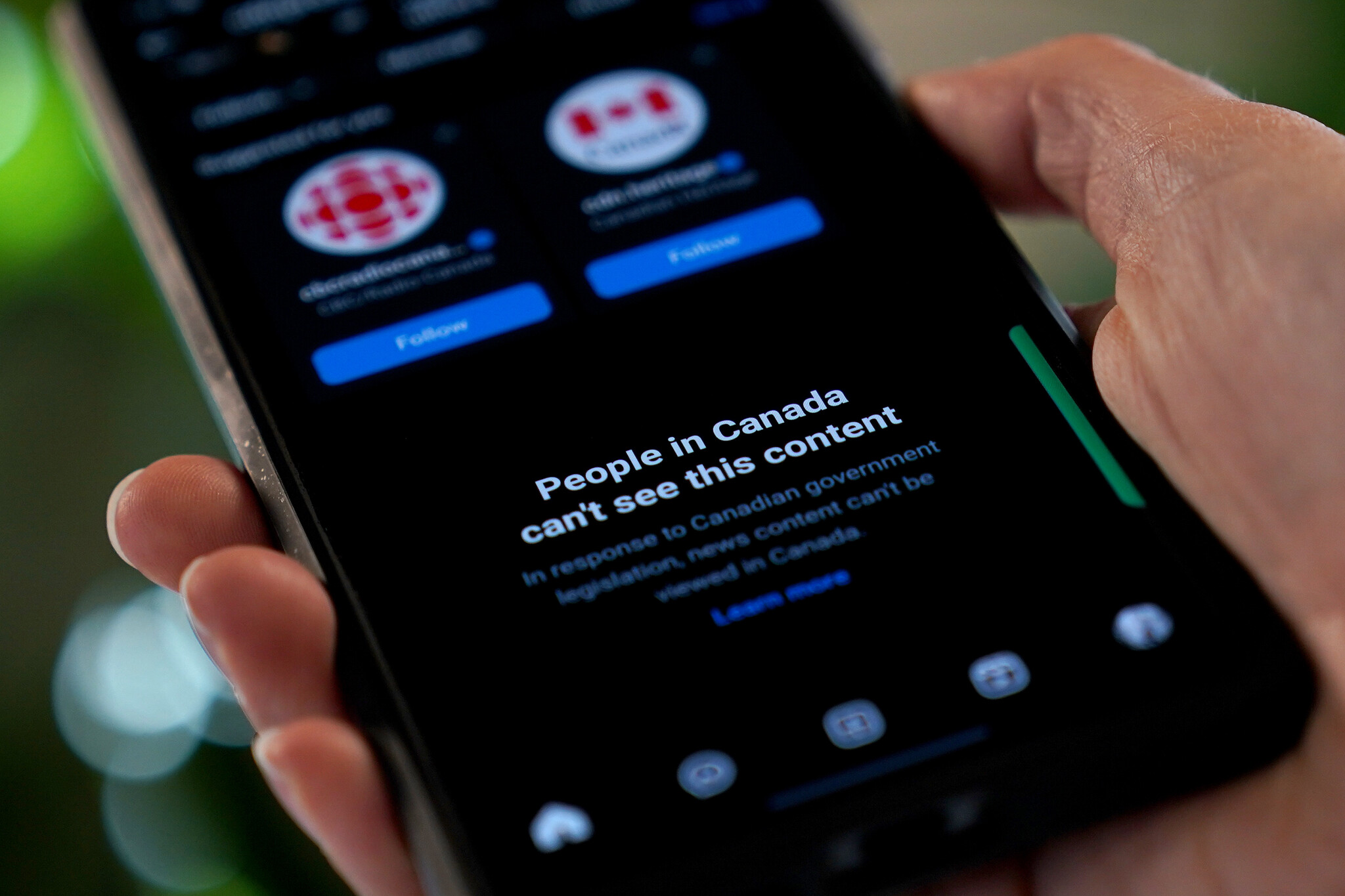As the saying goes, something wicked this way comes. Well, not really. But kind of. If you’re a media-industry obsessive like me, you may have seen numbers come out over the last week indicating a sea change in the (patchwork) bedrock that news media and journalism have built themselves on since the explosion of dot-com, search, and social.
Earlier this week, The Hub’s publisher, Rudyard Griffiths, reported on the rollout of Google’s AI Overviews and, in the U.S., AI Mode. These tools, he points out, have correlated with skyrocketing zero-click searches. In layman’s terms, this means that more people are hovering on Google’s little AI-generated news summaries than they are clicking through to the actual sites that supply their information.
Puck’s Julia Alexander rightfully called this Google’s “Zero Dark Thirty” moment. Think of it this way: ChatGPT, since its rise, has posed an existential threat to the very model of search. News-related prompts on the platform rose 212 percent between 2024 and 2025. In an interview, Google CEO Sundar Pichai said he thought AI would be “bigger than the internet.” Clearly, he meant it. For Pichai to have directed his team of engineers to shift their focus towards AI-search tools represents a willful cannibalization of the company’s traditional business model in order to get ahead in the future of search.
Google, at its core, is a tech-enabled advertising company. The bulk of its revenue comes from ads on its traditional search engine. But AI Mode flips that model on its head, directing people more towards the summaries that are now, according to the data, taking them away from the rest of the links and pages below.
What’s new is old, what’s old is new
For publishers, though, this all might be more like Groundhog Day. In the early aughts and through the 2010s, the rise of digital practically swept ad revenues (think classifieds, product placements, and more) and eyeballs out from under print media. Budgets fell, jobs were lost, expense accounts thinned, the Golden Age of journalism came to a withering halt—as the recent avalanche of media retrospectives from Graydon Carter and others reminds us. In short, at the time, the media somewhat missed the forest for the trees, and now the Nicholas Thompsons, Will Welches, Jeffrey Goldbergs, and Emma Tuckers of the world are playing catch-up, trying to rectify it. This generation of editors adjusted course and built their newsrooms around the principles of SEO, digital-first content, and, where possible, virality. With this next wave, though, publishers likely won’t be afforded that second chance to recover retroactively.
Canadian media’s call to action
The Canadian media story in all of this is at risk of being the most tragic of all. Need I bemoan the web interfaces of some of our nation’s most highly esteemed publications that look stuck in 2008? And in terms of the digital news avalanche, we’ve arguably already had our own forest-for-the-trees moment. The politicians implementing the Online News Act, for example, spent years litigating the problem of how to get the current tech advertising duopoly to “pay up.” This, in and of itself, is not an unworthy goal, but the means to the end were unsatisfying. While Google struck a deal to compensate Canadian news outlets, Meta responded by removing all news content in our country.

A smartphone showing Meta’s blocking of Canadian news content on their Instagram social media app is shown in a photo illustration, in Toronto, Thursday, Aug. 1, 2024. Giordano Ciampini/The Canadian Press.
I have had a hard time understanding how a resolution that sees news blocked for all Canadians on Instagram and Facebook—two of the top sites where Canadians, especially young ones, get their information—is an acceptable steady-state. For one thing, it leaves people vulnerable to disreputable, potentially harmful misinformation from pages not formally classified as “news,” but generating public interest opinion content anyway. What’s more, it also cuts off two major channels for Canadian publishers to push their content and compete in the global ecosystem. The great irony of all this—regardless of where you fall on the spectrum of agreement with the premises and conclusions of the Online News Act—is that those Facebook and Google link referrals were the key means by which publishers could generate the traffic that they now rely upon to generate revenue.
In pushing through the Online News Act when we did, I’m almost left thinking that we jumped the gun. We spent so much time squabbling about links that we missed the behemoth coming down the track. The legislative system built its case for payment extraction around links and referrals, tools which ultimately funnelled attention towards Canadian outlets. Now, not only has a tool been built that diverts attention, but it also scrapes, uses, and, arguably, exploits the reporting of those same outlets to generate its own, proprietary product. This feels, to me, far more like intellectual property theft and an unfair abuse of monopoly power than link sharing. Just two years after the implementation of Canada’s landmark (well-meaning, if ill-fated) Online News Act, it’s already out of date.
A fork in the road: Where publishers go next
So, what’s the remedy here? For starters, some kind of renegotiation of the Online News Act feels unavoidable. But there has to be more. Any publisher of news or media of any kind needs to be game-planning immediately. Legislators do, too. Still, government intervention can’t be the only bulwark against this change. Innovation has to keep pace.
Some outlets in the U.S. have been ready for this tidal wave. Notably, the New York Times sued OpenAI for its unauthorized use of Times content in training its large language models (LLMs). A coalition of several key Canadian outlets, such as Torstar, Postmedia, CBC, the Globe and Mail, and the Canadian Press, all did the same. Other outlets—including Associated Press, News Corp., and FT Group—have struck deals with OpenAI, licensing their content for training on its models (and occasionally their journalistic counsel) in exchange for some general combination of monetary compensation and proprietary information on its referral strategies. The Times itself struck a similar deal with Amazon. These deals almost remind me of those negotiated with Spotify and other music streaming platforms by major record labels back in the 2010s to address the freefall the industry was in during the Napster/piracy era.
But not all outlets are created equal. Not all will have the resources or information-generating power necessary to play at that level. This dynamic makes me wonder if news will bifurcate, with information providers on one side and novelty commentators on the other.
The information generators
In the former bucket, I see outlets such as the Canadian Press, Associated Press, Reuters, and possibly even the CBC and National Post. If AI Overviews and AI Mode really do overtake traditional search engines in terms of information delivery, as the early numbers suggest, the era of people looking to outlets to “break” all the news could be over. There’s a world in which these larger, established newsrooms essentially become wire services licensed by and feeding content to AI. One can easily imagine that the next phase of search engine optimization (SEO) is really artificial intelligence optimization (AIO), optimizing the placement of journalists’ investigative work in both the source referral systems of programs like ChatGPT and the share of models that pull from their content. After all, the LLMs still need content to scrape to stay accurate and up-to-date. As of now, AI can’t break news; it can only synthesize it. Putting all the world’s working journalists out of business—at least given how LLM technology currently works—probably isn’t in their best interest either. But how many news-breakers do we really need? Is there even a scenario where journalists go in-house at Google or OpenAI, finding and writing stories for the consumption of AI language models instead of for the public?
The civic cost here has to be noted. Media is a business, but civic information is a public good. If larger newsrooms are the only ones that can meet the supply demands of LLMs—and the only ones with the power to negotiate deals—then the current problems of news desertification facing Canada and other countries will only be exacerbated. There’s the obvious fact that jobs will be lost, and small local newsrooms will be the first to close. But even larger, national publishers could suffer too. The publishers that do survive will likely be indebted to the AI powerhouses in some way. And if a monopoly or duopoly scenario emerges, editorial guardrails will need to be established to maintain independence and journalistic rigour.
There’s also, on the other hand, the case for grabbing the bull by its horns. Perhaps, with a redirect, AI tools could enable information-first newsrooms to get to the heart of stories that matter faster, using the time freed up by easier access to information to turn over stones previously left untouched. Picture an AI that can help journalists run through thousands of pieces of otherwise overly cumbersome government spending data in seconds. Or one that quickly aggregates decades of city council voting records.
The niche commentators
Then, there’s the latter bucket: novelty commentators who are able to insulate themselves from the AI by offering the most interesting takes from compelling human personalities. This approach is already being championed by many, buoyed by subscription revenue. At The Atlantic, top editors have transformed the magazine into a conglomeration of all-stars, shelling out $300,000-plus salaries for the best of the best essayists, investigators, interviewers, and storytellers. Their selling point is expert analysis for policy wonks and obsessives, specialty niche reportage, and access to high-power interviewees. Other outlets such as Air Mail (hello again, Graydon Carter!), Puck, The New Yorker, The Free Press, Semafor, and WSJ Magazine have all done the same. And this is not even mentioning the wealth of Substack writers, Twitch streamers, YouTube video essayists, and more developing their own brands as well. In this news economy, the Ezra Kleins, David Frums, Fareed Zakarias, Bari Weisses, Rosemary Bartons, and Ian Hanomasings win.
What these outlets and individuals do, though, is fundamentally different from what the old guard of newsmen once did. Yes, there are still big scoops and first-mover incentives on stories, but what gives this class of publications their edge is the depth of their analysis, the novelty of their commentary, and their ability to provide perspective and personality as much as convey information. News thus becomes a novelty good, one that intellectually delights as much as it serves “just the facts, ma’am.”
Of course, enjoy this content as you might—I certainly smile when I see Puck in my inbox—it also forces us to question what happens to the common fabric of shared facts if opinion or analysis becomes the centerpiece of the news world instead of its complement; AI left to fill the void of the rest. In such a scenario, the echo chamber problem potentially becomes even more amplified.
Calm before the storm
Where the dust settles on all of this for Canada’s publishers remains to be seen. There’s a strong business case for leaning into the novelty approach. Many digital-native businesses built on this model—including but not limited to those aforementioned—have actually had a surprising degree of financial success. However, in a zero-click world, even the success of that model appears shaky.
Independent, local, and smaller outlets could suffer the most in any of these scenarios, that is no question. But perhaps by pursuing more innovative models akin to those in the second bucket, there is a way out. Or at least a way forward. Regardless, digging heels in and trying to “do things the old way” until it all breaks will not be an option.
Lawmakers, for their part, need to get smart on the future of this technology, and quickly. If information-conveying power is ceded from traditional search-engine news referrals to AI-generated news synthesis, it’s hard to argue against oversight of some kind, at least in the way of preventing misinformation and preserving ethics. But this oversight has to be agile, not cumbersome and prehistoric.
Big tech has played its opening hand. The ball is now in the media industry’s court.








